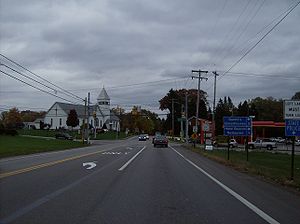
Meridian, Pennsylvania
Encyclopedia

Census-designated place
A census-designated place is a concentration of population identified by the United States Census Bureau for statistical purposes. CDPs are delineated for each decennial census as the statistical counterparts of incorporated places such as cities, towns and villages...
(CDP) in Butler County
Butler County, Pennsylvania
-Demographics:As of the census of 2000, there were 174,083 people, 65,862 households, and 46,827 families residing in the county. The population density was 221 people per square mile . There were 69,868 housing units at an average density of 89 per square mile...
, Pennsylvania
Pennsylvania
The Commonwealth of Pennsylvania is a U.S. state that is located in the Northeastern and Mid-Atlantic regions of the United States. The state borders Delaware and Maryland to the south, West Virginia to the southwest, Ohio to the west, New York and Ontario, Canada, to the north, and New Jersey to...
, United States
United States
The United States of America is a federal constitutional republic comprising fifty states and a federal district...
. The population was 3,794 at the 2000 census.
History
Meridian was linked to ButlerButler, Pennsylvania
The city of Butler is the county seat of Butler County in the U.S. state of Pennsylvania, situated north of Pittsburgh. The population was 15,121 at the 2000 census.- History :...
, Evans City
Evans City, Pennsylvania
Evans City is a borough in Butler County, Pennsylvania, United States. The population was 2,009 at the 2000 census.-Geography:Evans City is located at ....
and Pittsburgh in 1908 by the Pittsburgh, Harmony, Butler and New Castle Railway
Pittsburgh, Harmony, Butler and New Castle Railway
The Pittsburgh, Harmony, Butler and New Castle Railway, commonly called the Harmony Line, was a broad gauge interurban streetcar line connecting Pittsburgh, Pennsylvania, United States to Butler and New Castle via Harmony and a split at Evans City...
, an interurban
Interurban
An interurban, also called a radial railway in parts of Canada, is a type of electric passenger railroad; in short a hybrid between tram and train. Interurbans enjoyed widespread popularity in the first three decades of the twentieth century in North America. Until the early 1920s, most roads were...
trolley line. The line closed on 15 June 1931 and the trolleys were replaced by buses.
Geography
Meridian is located at 40°51′16"N 79°57′23"W (40.854415, -79.956359).According to the United States Census Bureau
United States Census Bureau
The United States Census Bureau is the government agency that is responsible for the United States Census. It also gathers other national demographic and economic data...
, the CDP has a total area of 2.8 square miles (7.3 km²), all of it land.
Demographics
As of the censusCensus
A census is the procedure of systematically acquiring and recording information about the members of a given population. It is a regularly occurring and official count of a particular population. The term is used mostly in connection with national population and housing censuses; other common...
of 2000, there were 3,794 people, 1,489 households, and 1,137 families residing in the CDP. The population density
Population density
Population density is a measurement of population per unit area or unit volume. It is frequently applied to living organisms, and particularly to humans...
was 1,337.7 people per square mile (515.8/km²). There were 1,524 housing units at an average density of 537.3/sq mi (207.2/km²). The racial makeup of the CDP was 99.24% White, 0.18% African American, 0.08% Native American, 0.29% Asian, 0.08% Pacific Islander, and 0.13% from two or more races. Hispanic or Latino of any race were 0.37% of the population.
There were 1,489 households out of which 28.0% had children under the age of 18 living with them, 67.7% were married couples
Marriage
Marriage is a social union or legal contract between people that creates kinship. It is an institution in which interpersonal relationships, usually intimate and sexual, are acknowledged in a variety of ways, depending on the culture or subculture in which it is found...
living together, 6.2% had a female householder with no husband present, and 23.6% were non-families. 21.1% of all households were made up of individuals and 11.5% had someone living alone who was 65 years of age or older. The average household size was 2.52 and the average family size was 2.93.
In the CDP the population was spread out with 21.3% under the age of 18, 5.5% from 18 to 24, 25.1% from 25 to 44, 29.9% from 45 to 64, and 18.2% who were 65 years of age or older. The median age was 44 years. For every 100 females there were 96.9 males. For every 100 females age 18 and over, there were 93.8 males.
The median income for a household in the CDP was $48,939, and the median income for a family was $57,893. Males had a median income of $44,458 versus $27,933 for females. The per capita income
Per capita income
Per capita income or income per person is a measure of mean income within an economic aggregate, such as a country or city. It is calculated by taking a measure of all sources of income in the aggregate and dividing it by the total population...
for the CDP was $22,962. About 3.9% of families and 6.3% of the population were below the poverty line, including 2.3% of those under age 18 and 13.8% of those age 65 or over.

